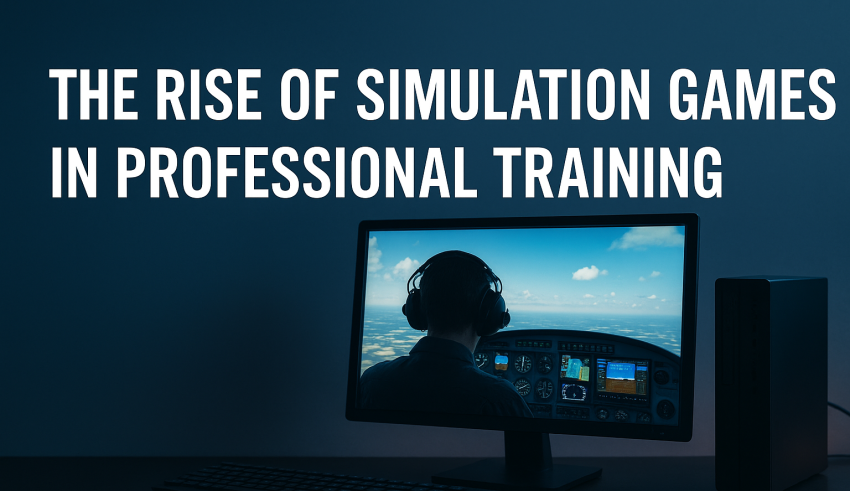Learn how simulation games transform professional training through data-driven learning, realism, and performance analytics for better workplace results
The Rise of Simulation Games in Professional Training
The boundaries between gaming and education are blurring faster than ever. Simulation games, once designed for fun, now train real-world professionals. From aviation to business strategy, these platforms allow learners to practice in safe, data-rich environments.
One global platform like 1xbet so.1xbet.com/en , has shown how digital ecosystems can turn interactivity into measurable outcomes — combining precision and immersion.
Why Simulation-Based Learning Works
The psychology behind it is simple: active participation triggers stronger memory and emotional connection. When someone manages a virtual business or lands a digital aircraft, their brain processes it like a real event. This emotional anchor boosts both confidence and competence.
Professionals prefer learning that feels real. Static manuals are outdated; dynamic simulations adapt and react. This immediate feedback loop turns learning into measurable behavior change—something traditional education struggles to achieve.
Real-World Adoption Across Industries
Simulation-based learning isn’t limited to technical fields anymore. Finance, retail, and even leadership training programs now use interactive platforms to model business environments. Here’s a quick comparison of sectors adopting simulation for training:
| Industry | Application | Key Benefit |
| Aviation | Flight simulators for pilot training | Risk-free environment to master complex systems |
| Healthcare | Surgery and patient simulations | Improved accuracy and faster decision-making |
| Business & Management | Virtual enterprises and crisis models | Better leadership and collaboration skills |
Modern corporations see training as investment, not expense. The data shows it: companies that apply simulation training report 42% faster skill retention and 30% lower training costs compared to traditional courses.
Data Analytics and Real-Time Feedback
One of the biggest strengths of simulation games is analytics. Every click, choice, and reaction becomes measurable data. These insights help coaches personalize programs and assess performance without bias.
Imagine a virtual call center where each trainee’s tone, timing, and conflict resolution are tracked automatically. The system scores emotional intelligence, speed, and clarity—metrics impossible to capture in a standard test.
This analytical backbone is changing corporate culture. Instead of yearly reviews, feedback now happens in real time. It’s like having a digital mirror that reflects performance instantly, making improvement continuous and data-backed.
| Type of Data Collected | Use Case | Outcome |
| Decision patterns | Strategy assessment | Identifies leadership traits |
| Reaction times | Emergency training | Improves reflex and calmness |
| Communication style | Sales & support | Enhances persuasion and clarity |
The Technology Powering It All
Modern engines use physics modeling, AI opponents, and biometric tracking. Learners can face digital emergencies that feel authentic—adapting based on skill level and stress response. The result? A learning experience tailored for real-world challenges.
Three leading technologies in simulation training include:
- AI Learning Systems – Customize training based on user progress and mistakes.
- VR/AR Interfaces – Immerse users in tactile, sensory-rich environments.
- Cloud-Based Collaboration – Allow multiple users to train together remotely.
These technologies also make training accessible anywhere, reducing the need for physical facilities and hardware. That accessibility makes simulation the most scalable form of education today.
A typical corporate training game might include progress bars, team missions, and scenario-based rewards. This structure creates friendly competition and engagement without pressure. Employees often describe it as “learning disguised as play.”
This isn’t accidental. Behavioral scientists call it “gamified cognition”—the process of learning through structured motivation.
Economic and Organizational Impact
Training budgets are changing direction. In 2025, over 65% of Fortune 500 companies are expected to integrate simulation-based systems into workforce development. The reason is simple: cost efficiency and scalability.
Here’s a snapshot comparing training methods:
| Training Type | Average Cost per Employee | Retention Rate | Accessibility |
| Traditional workshops | $1,200 | 45% | Limited |
| Online video courses | $600 | 60% | High |
| Simulation-based training | $800 | 85% | Global |
A New Standard for the Future Workforce
The next generation of professionals won’t see a line between work and simulation. For them, digital experience is real-world preparation. Universities and corporations now cooperate to embed simulation into formal education, turning students into job-ready professionals before graduation.
As industries compete for skilled professionals, those embracing simulation-first learning gain an undeniable advantage. It’s a shift that’s rewriting professional development as we know it — one virtual decision at a time.
The Human Element Behind the Digital World
Despite the algorithms, visuals, and automation, simulation training remains human at its core. Every scenario reflects real emotions — stress, teamwork, curiosity. The best systems capture those nuances and translate them into measurable growth.
It’s not about replacing trainers — it’s about enhancing them with tools that make feedback precise and progress visible. The digital and human worlds finally meet on equal terms.
The simulation era is here to stay. Its success lies in making professional growth feel like discovery, not obligation. By combining analytics, realism, and motivation, simulation-based training turns learning into an adventure that matters.







